23. Non-infectious, infectious, & parasitic diseases of nervous system in respective pig categories
1/61
Earn XP
Description and Tags
(Sunstroke, overheating, Congenital tremor, Adenovirus infection, Aujezsky’s disease, Teschen disease, Viral encephalomyocarditis, Japanese B encephalitis, Eastern encephalomyelitis of horses, Coronavirus encephalomyelitis in piglets, Nipah-virus disease, Blue eye disease, Rabies, Streptococcus meningitis, Listeriosis, Tetanus, Toxoplasmosis)
Name | Mastery | Learn | Test | Matching | Spaced |
|---|
No study sessions yet.
62 Terms
What are examples of non-infectious, infectious, and parasitic diseases of the nervous system?
Non-infectious
Sunstroke/hyperthermia
Congenital tremor
Hydrocephalus, intoxications, iron toxicity, hypothermia, hypoglycaemia
Infectious
Aujeszky’s
Rabies
Teschen disease
Coronavirus encephalomyelitis
Viral encephalomyocarditis
Blue-eye disease
Nipah
Porcine meningitis
Tetanus
Parasitic
Toxoplasmosis
Ascaris suum
What is the main cause of sunstroke and hyperthermia in swine?
Extreme temperatures and water shortages
What can sunstroke and hyperthermia in pigs lead to?
Weakness, diarrhoea, acute distress, and even death
What are common clinical signs of sunstroke and hyperthermia in swine?
Stress, tachypnoea, muscle tremor, weakness, vomiting, diarrhoea, pyrexia, convulsions, spasms
What is the treatment for sunstroke and hyperthermia in pigs?
Emergency fluids and electrolytes, cold water into the rectum, and cold water spray
What is congenital tremor in pigs?
A sporadic disease seen in newborn pigs, marked by tremors and shaking of the head and body
What are the causes of congenital tremor in pigs?
Circovirus, classical swine fever, genetic factors, teratogens, Aujeszky's disease, Japanese encephalomyelitis virus
What are the clinical signs of congenital tremor in pigs?
Tremor during waking moments, difficulties in walking and feeding, spontaneous recovery, exacerbation by cold and excitement
How can congenital tremor in pigs be managed?
Assisted feeding and immunisation of gilts
What other non-infectious conditions can affect pigs besides sunstroke and congenital tremor?
Hydrocephalus, intoxications, iron toxicity, hypothermia, hypoglycaemia
What is Aujeszky’s disease in pigs?
A highly contagious and economically significant disease caused by suid alphaherpesvirus 1, DNA
How is Aujeszky’s disease transmitted?
Mainly through respiratory or oral routes, but also venereal transmission is possible
What are the clinical signs of Aujeszky’s disease?
Newborn: fever, depression, vomitus, tremor, ataxia, convulsions, mortality (100%)
3-4 weeks: nervous signs, pharyngeal lesions- voice change, mortality (50-70%),
4 weeks- 3 months: anorexia, mild fever, low mortality
Adults: pyrexia, anorexia, cough, nasal discharge, rare CNS signs
Sows: poor fertility, abortion, small litters
How is Aujeszky’s disease diagnosed?
Immunofluorescence, immunoperoxidase test, virus neutralisation, DNA dot-blot hybridization for latent virus, serological tests (VNT and ELISA)
What is rabies in swine?
A viral disease caused by the neurotropic rabies lyssavirus, leading to inflammation of the brain
What are the initial clinical signs of rabies in pigs?
Restlessness, anorexia, increased appetite, vomiting, slight fever
What are the advanced signs of rabies in pigs?
Twitching of the nose, pruritus at the bite site, excitement, aggression, convulsions, paralysis, excessive salivation, chewing motion, death within 48 hours

What is Teschen disease in pigs?
A disease caused by a porcine enterovirus, serotype 1 from the Picornaviridae family, affecting pigs of all ages
What is the difference between Teschen disease and Talfan disease?
Teschen disease is more severe, while Talfan disease is a mild form caused by less virulent strains of the virus
How does the Teschen virus spread in pigs?
The virus enters orally, replicates in the tonsils and intestines, spreads haematogenously to the central nervous system
What conditions must be present for the Teschen virus to damage the CNS?
Absence of specific circulating antibodies or when they are at insufficient levels
What are the general clinical signs of Teschen disease?
Anorexia, depression, irritability, paresis of the extremities
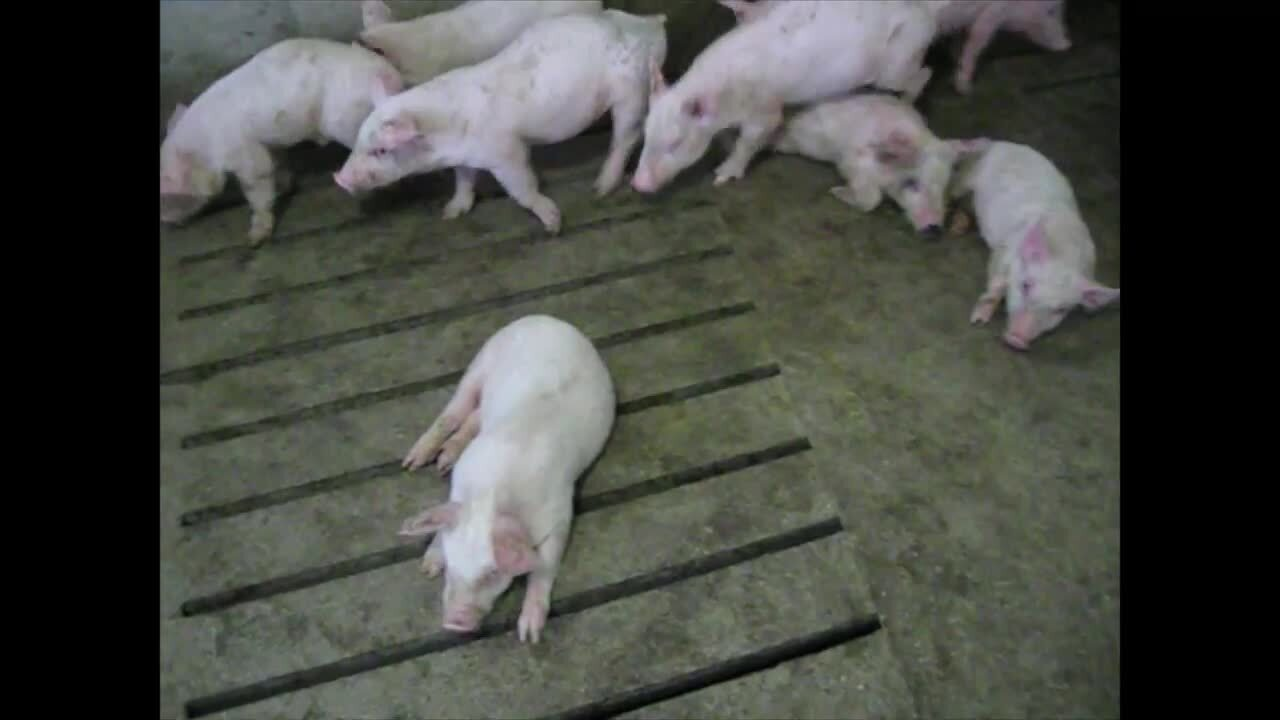
What are the severe clinical signs of Teschen disease?
Tremors, nystagmus, violent clonic convulsions, collapse, coma, sudden temperature drop, death within 3-4 days
How is Teschen disease diagnosed?
Clinical signs, ELISA, VNT, virus isolation
What is the treatment and prevention for Teschen disease?
No effective treatment; prevention through all-in, all-out management and vaccination
What is the cause of coronavirus encephalomyelitis in pigs?
Porcine haemagglutinating encephalomyelitis virus (PHEV), coronavirus, RNA
How is coronavirus encephalomyelitis transmitted?
Presumably through infectious nasal secretions or aerosol
What age group of pigs is most affected by coronavirus encephalomyelitis?
Pigs less than four weeks old
What are the clinical signs of coronavirus encephalomyelitis in pigs?
Vomiting & wasting syndrome: Sneezing & coughing, vomiting of milk & retching.
Encephalomyelitis syndrome: Initial signs are similar to those above. Later, a variety of signs of encephalomyelitis appear- stilted gait, muscle tremors, nystagmus, blindness, opisthotonus, convulsions, & progressive paresis leading to recumbency w/ paddling of the legs.
What treatment is available for coronavirus encephalomyelitis in pigs?
No treatment; prevention is through injection of hyper-immune serum at birth or exposing gilts to faeces of older sows
What is the causative agent of viral encephalomyocarditis in swine?
Members of the genus Cardiovirus, family Picornaviridae, RNA
How is viral encephalomyocarditis (EMC) transmitted?
Through rodent excretions and via nasal secretions and faeces of pigs
What are the clinical signs of viral encephalomyocarditis in pigs?
Sudden death, fever, anorexia, listlessness, trembling, staggering, dyspnea, and paralysis
What age group of pigs is most affected by viral encephalomyocarditis?
Suckling swine, with mortality approaching 100%
What virus causes blue eye disease in pigs?
Porcine rubulavirus (PoRV), Paramyxoviridae, an enveloped RNA virus
How is blue eye disease transmitted in pigs?
Through direct contact (nose-to-nose)
What are the clinical signs of blue eye disease in piglets?
Blindness, nystagmus, dilated pupils, anterior uveitis, conjunctivitis, swollen eyelids with exudate, and corneal opacity
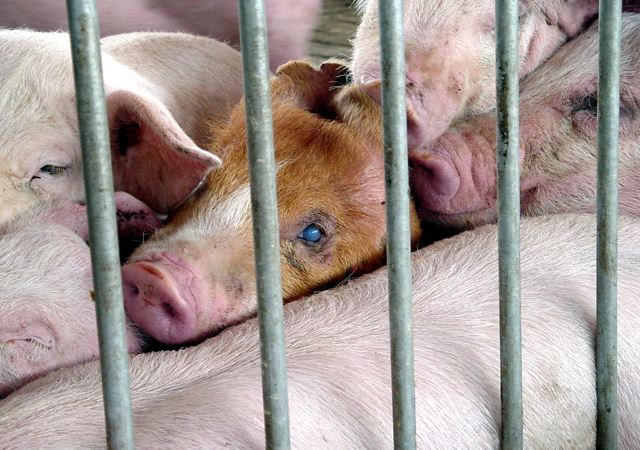
What are the reproductive effects of blue eye disease in sows and boars?
Irregular return to oestrus, stillbirth, mummification, orchitis, epididymitis, testicular atrophy, decreased spermatozoon concentration and motility
What methods are used to diagnose blue eye disease in pigs?
Culturing in pig kidney cell lines, direct immunofluorescence, RT-PCR, hemagglutination inhibition, virus neutralisation, and ELISA
What is the most common cause of meningitis in pigs?
Streptococcus suis infection
What other conditions can Streptococcus suis cause in pigs?
Septicaemia, arthritis, endocarditis, myocarditis, and abortion
How is Streptococcus suis transmitted in pigs?
Clinically healthy pigs can carry the organism in their tonsils, nasal mucosa, and vagina for many months; transmission may occur through ingestion, inhalation, or nose-to-nose contact
What is the pathogenesis of porcine meningitis?
Oral/respiratory infection → tonsils → mandibular lymph nodes → septicaemia → phagocytes → CSF (brain, meninges), joints, lungs, reproductive system
What are the clinical signs of meningitis in pigs?
Sudden death, fever, anorexia, depression, tremors, ataxia, convulsions, and blindness; lameness and swelling if arthritis is present
How is porcine meningitis diagnosed?
Clinical signs, necropsy, & isolation of organism from CSF, brain, lungs, synovial fluid or heart
What is the causative agent of tetanus in pigs?
Clostridium tetani
How does Clostridium tetani enter the body?
Through a break in the skin, such as a cut or puncture wound from a contaminated object
What is the pathogenesis of tetanus?
C. tetanus produces toxins which interfere with muscle contractions
What are the clinical signs of tetanus in pigs?
Spasms starting in the jaw and progressing to the rest of the body, potentially severe enough to cause bone fractures
How is tetanus treated?
Amoxicillin is early enough. Kills bacteria, not toxins
What species causes Toxoplasma infection in pigs?
Toxoplasma gondii
What are the common clinical signs of Toxoplasma infection in pigs?
Mild or asymptomatic, laboured breathing, CNS signs, foetal losses, abortion in early pregnancy, stillbirths, and mummification in later gestation
What are examples of other agents causing neurological disease?
Porcine adenovirus
Nipah virus
CSF, ASF
Eastern equine encephalitis
Japanese encephalitis
Listeria monocytogenes
What neurological symptoms can be caused by porcine adenovirus?
Dullness, depression, lethargy, listlessness, and tremors, often secondary to dehydration
What are the body systems affected by Nipah virus??
Brain (encephalitis; convulsions) and respiratory system
What are the effects of classical swine fever and African swine fever?
Discoloration of skin, high fever, haemorrhages, acute staggering, incoordination, and paresis
What disease is caused by the Eastern equine encephalitis (EEE) virus?
A zoonotic alphavirus and arbovirus that affects horses and other mammals, causing brain damage and neurological signs
Abnormal gait, aimless wandering, circling, dyspnoea, drowsiness, head pressing, hyperactivity paralysis, restlessness, sensitivity to sound, & death
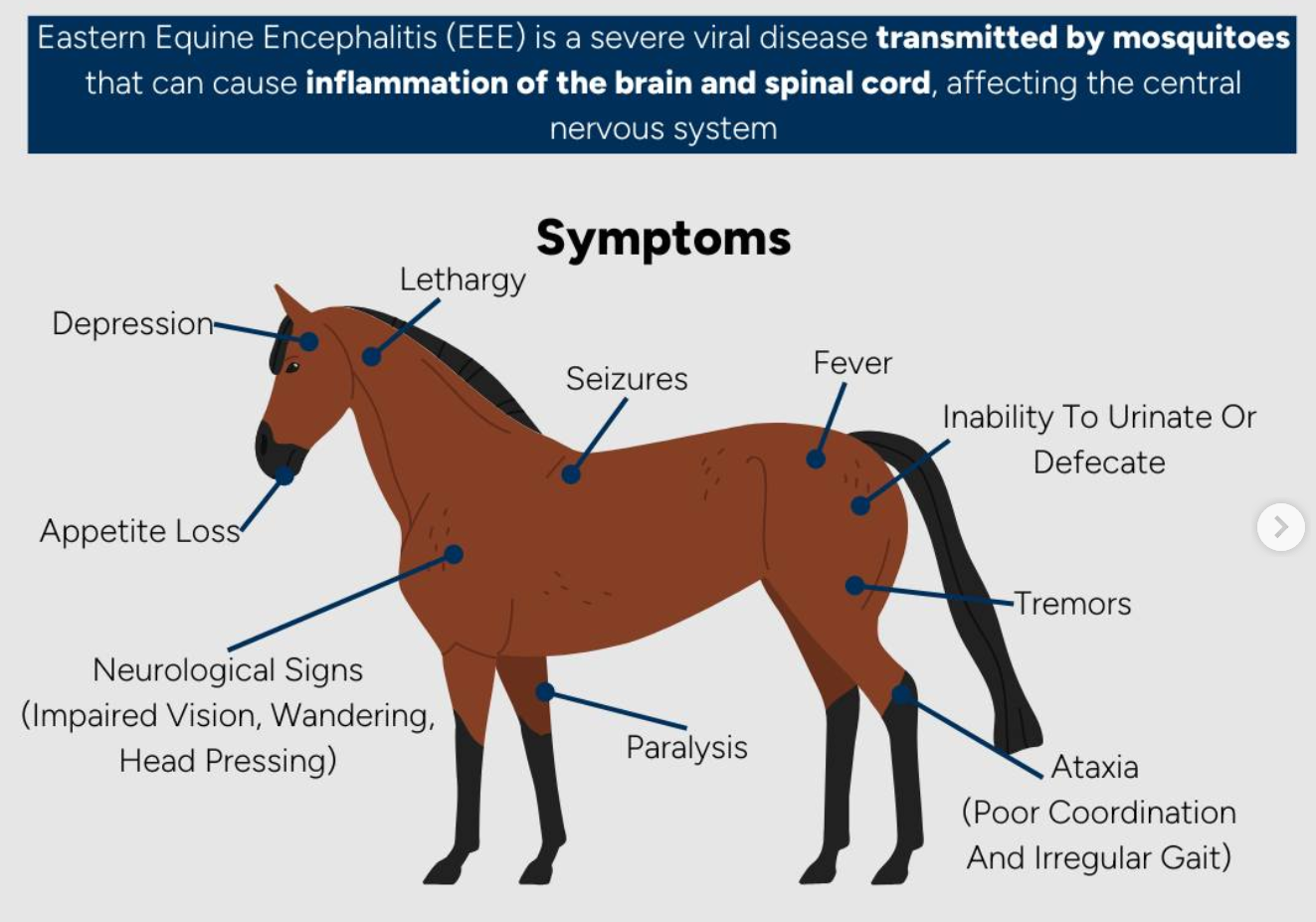
What is the main transmission vector for Japanese encephalitis virus?
The Culex mosquito
What are the primary clinical signs of Japanese encephalitis in pigs?
Reproductive losses (testes) and potential CNS effects
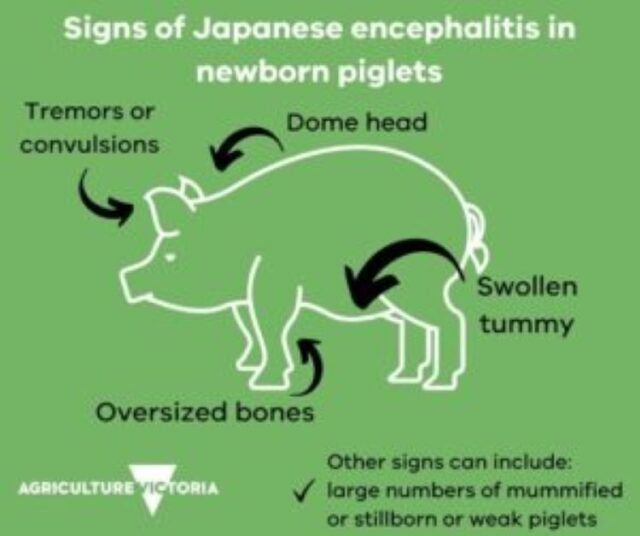
What animal species is most commonly affected by listeriosis caused by Listeria monocytogenes?
Ruminants, especially sheep, though a variety of animal species can be infected
What are the clinical signs of the encephalitic form of listeriosis?
Stiff gait, paralysis of face and limbs, and opisthotonus
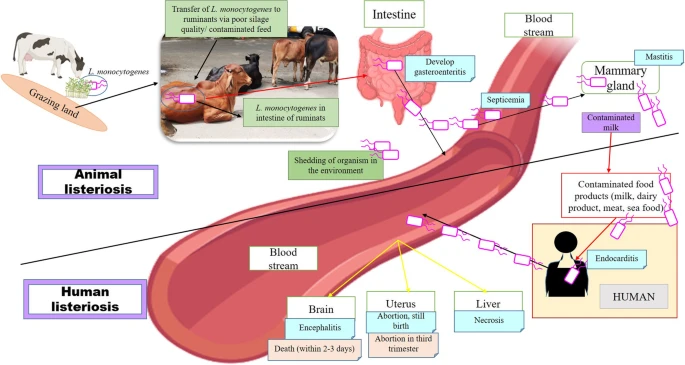
What is the aetiological agent of glassers disease?
Glaesserella parasuis